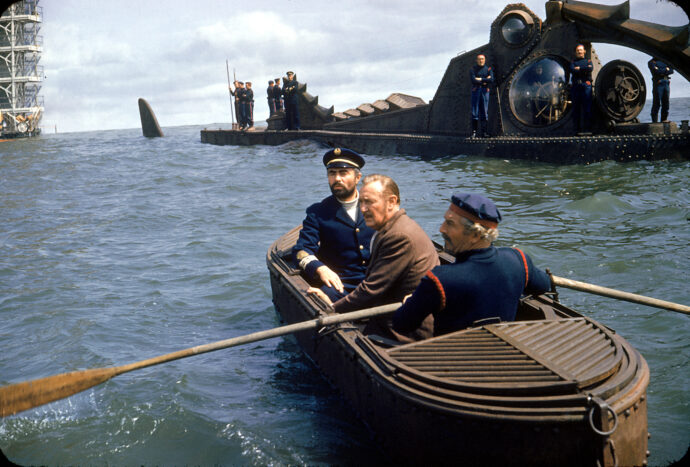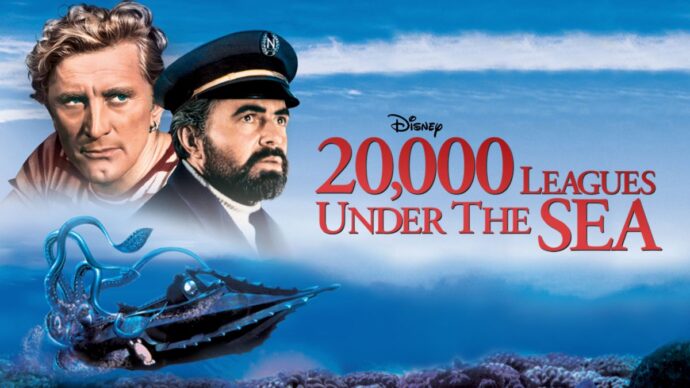Plus or Minus is a series detailing and analyzing every feature film now streaming on Disney+. It combines the unique history all these films share, their cultural impacts, and their qualities, or lack thereof. From timeless classics, to acquired hits, to DCOMs, no stone will be left unturned.
As I continue Plus or Minus, I dive 20,000 Leagues Under the Sea. Based on the popular Jules Verne novel, this is perhaps the most high-profile live-action piece Walt Disney Productions has ever made until Mary Poppins. There’s a lot of firsts I will get into with this, but first a quick plot summary, as usual.
Rumors spread of a sea monster in the Pacific Ocean taking down ships one by one. A frigate is set to vanquish the beast, with the captain being Professor Aronnax (Paul Lukas) and his assistant Conseil (Peter Lorre). Also part of the team is the cocky and boisterous harpooner Ned Land (Kirk Douglas). However, the sea monster turns out to be a submarine owned by the mysterious and brilliant Captain Nemo (James Mason).
Nemo, both a genius and madman, wants to launch a crusade against the seven seas and the world itself. Therefore, the captive crew have to expose this evil plan before it’s too late.
Disney’s Live-Action Opus
By the 1950s, Disney and their live-action department had already been pumping out consistent features. Treasure Island proved to be a success and three other live-action adventure titles followed suit. The Story of Robin Hood, which I already talked about, The Sword and the Rose in 1953, and Rob Roy: The Highland Rogue in 1954. All three were directed by Ken Annakin and starred Richard Todd. The latter two are not on Disney+, though they could be added in the future.
Anyways, 20,000 Leagues came about when Walt Disney saw marine footage and storyboards from Harper Goff for the True-Life Adventures series. Goff had been with Warner Bros., designing sets for Captain Blood and Casablanca, and later planned concept art for Disneyland. Disney was impressed with Goff’s work and thought this would lead to a wonderful film adaptation of the Verne classic. And after a few years of rights negotiations, Walt made his biggest, greatest live-action film yet.
It even revitalized the directing career of an underrated talent. Richard Fleischer had already found success with films like The Clay Pigeon and The Happy Time. He earned a Golden Globe nomination for the latter. But with this release, Fleischer would find himself on tentpole projects, including The Vikings, Fantastic Voyage, Doctor Dolittle, Tora! Tora! Tora!, Soylent Green, Conan the Destroyer, and Red Sonja. The reactions to those films are varied.
A Roaring Success
Of course, Walt’s other adventure titles were big, but 20,000 Leagues was on a whole other level. Incredible special effects unlike anything the company had done before. Major movie stars like Kirk Douglas, James Mason, Paul Lukas, and Peter Lorre. And a massive $9 million budget, the most expensive Disney movie ever. The stakes were high, as this film’s potential floppage might have damaged a company that was still trying to bounce back from World War II.
These fears did not matter in the end. 20,000 Leagues was a box office success, earning $28.2 million domestically. The movie also saw praise for being an exciting adventure film for all ages. Add on two Academy Award wins and it would become one of the most famous Disney live-action films ever. It recieved an opening month attraction at Walt Disney World, and attempts of a remake occurred throughout the years, with current plans for a Disney+ television series titled Nautilus.
This success is certainly understandable, as this is an absolute delight of a film. A stunning adventure with great set pieces, strong writing, and a very memorable ensemble. By all accounts, this is the kind of ingenuity that Disney films exceed at the most.

The Nuances of Captain Nemo
The cast is full of major A-listers, all of whom bring great material to their roles. Kirk Douglas serves well as the cocky hero, while Lukas serves well as the neutral party. Plus Peter Lorre’s a delight as usual. Yet James Mason’s Captain Nemo is what makes the film shine. He’s a Randian figure who hides his incredible tools away from humanity. Better yet, he has a strong hatred of humanity for its inhumane actions towards the world and for what it had done towards his family.
Watching Nemo, there is a tragic side to him. A man who believes that his atrocious actions are good and just, despite him being as bad, if not worse than his enemies. A man who is soft-spoken and charming, yet clearly with a screw loose due to years of isolation. James Mason is fantastic at delivering this complexity. A figure who is sadistic yet sympathetic all at once and delivers plenty of nuance. He’s the hidden reason why this film endures decades later.
A Technical Marvel
Still, this is a G-rated adventure film. So within all the complexities and character nuances is still a thrilling quest for all ages. Walt Disney uses this CinemaScope wonderland to his fullest advantage. The underwater sequences are jaw-dropping, immersing viewers into the oceanic world. While some will argue they go on for too long, I felt it was a fun way to show off some interesting tech.
Further beauty is also shown in the Nautilus itself. It features an inventive design and strong details that make it feel lived-in and lively and otherworldly. A wonderful contrast to the initial real-life world the characters inhabit.
This is all further punctuated by iconic set pieces. Each one more memorable than the last. From the heroes traversing the ocean floor to facing off against a giant squid to…fighting off native savages. That last part is pretty uncomfortable to watch today, but everything else still has a large scope, strong action, and memorable moments that are really fun no matter the age.

Plus or Minus?
The most exciting thing about 20,000 Leagues is really how it plays to all audiences. Within the exciting spectacle is still a heady drama with a lot of nuanced roles and characters. Not complex enough for a child to understand, yet still engaging and layered for an older audience. Disney has consistently done well in making all-ages fare, but 20,000 Leagues is somewhat unique. I’d argue it’s a film that skews more adult despite the adventure and cute sea lion (who by the way steals the whole movie). And that’s pretty interesting to see while going through this marathon. Even the best Disney films will always have the kiddie stamp to them. An older audience won’t always care for them. But 20,000 Leagues is a breath of fresh air and one that is worth a watch even for people not into the Disney brand.
So yes, between Plus or Minus, 20,000 Leagues Under the Sea is a very strong and enthusiastic Plus. There’s still some story beats and pacing issues in there, but it doesn’t distract from a strong big-budget adventure title.
NEXT TIME: We discover a miniseries reformatted into a film with Davy Crockett, King of the Wild Frontier. We all know the song, but is the movie a Plus or Minus?
